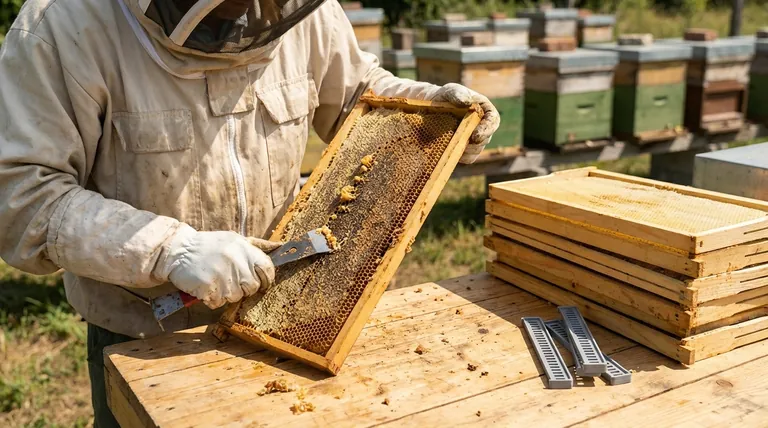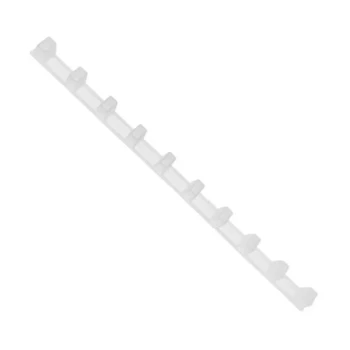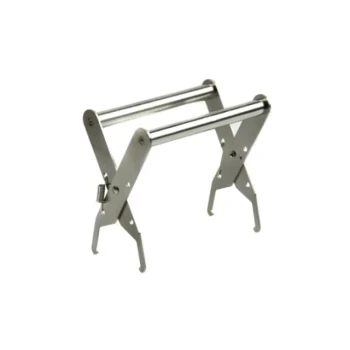As a general rule, beehive frames should be inspected during every hive check and thoroughly cleaned after each honey harvest. This routine ensures you catch potential issues like pests or damage early while maintaining the health of the colony and the quality of your honey.
The core principle is not about a rigid schedule, but about integrating frame maintenance into your regular beekeeping rhythm. Consistent inspection is your early warning system, while post-harvest cleaning is a fundamental reset for hive health and productivity.

The Role of Inspection: Your Early Warning System
Inspecting frames is about much more than just looking for honey. It is a critical diagnostic tool for understanding the state of your colony.
Checking for Structural Integrity
Frames can become damaged over time from handling or the weight of honey and bees. Look for broken wood, loose joints, or damaged foundation that could impede the bees' work or make future handling difficult.
Scouting for Pests and Disease
Close inspection of the frame's comb, brood, and corners is your first line of defense against pests like wax moths or hive beetles. It also allows you to spot signs of disease before they become a full-blown infestation.
Assessing Colony Resources
The frames tell the story of the hive. You can quickly assess the amount of stored honey and pollen, the health of the queen's laying pattern, and the overall strength of the colony's population.
The "Why" Behind Regular Cleaning
Cleaning frames after a honey harvest is not just about tidiness; it's a crucial step in proactive hive management. This process removes residual wax and propolis that can harbor pathogens.
Maintaining Colony Health
Old comb and propolis residue can become a breeding ground for bacteria and disease spores. A clean frame provides a fresh start, reducing the risk of transmitting diseases within the hive.
Ensuring Honey Quality
Residues from old brood or treatments can potentially contaminate future honey harvests. Cleaning ensures that the honey stored in the comb is pure and untainted.
Promoting Efficient Comb Building
Bees are more encouraged to build fresh, uniform comb on a clean foundation. This leads to stronger frames and more efficient use of space for both brood and honey storage.
The Practical Guide to Frame Cleaning
The cleaning process is straightforward but requires attention to detail to prepare the frame for its next use.
Step 1: Remove Old Comb
Begin by using a sharp knife to carefully cut any remaining comb away from the frame's foundation or wires.
Step 2: Scrape the Frame Body
Use your hive tool to scrape all surfaces of the frame, removing built-up wax, burr comb, and propolis. Pay special attention to the top and bottom bars where buildup is often heaviest.
Step 3: Detail the Grooves and Nooks
A small, flathead screwdriver is ideal for clearing wax and debris from the narrow groove in the bottom bar. Use a pick or similar small tool to ensure the pinholes in the sidebars are completely clear.
Common Pitfalls to Avoid
Effective frame management also means knowing what not to do. Avoiding these common mistakes will save you time and protect your bees.
Mistake 1: Unnecessary Cleaning
Do not scrape down healthy, fully drawn-out comb that you intend to return to the hive for the bees to refill. Bees expend significant energy drawing out wax, and reusing good comb gives them a major head start. Cleaning is for frames after extraction or those being taken out of service.
Mistake 2: Keeping Frames Indefinitely
Frames have a limited lifespan. Over several years, wax comb can accumulate pesticides and pathogens. A common best practice is to rotate out the oldest frames (roughly 20% of your total) each year, replacing them with new ones. This systematically reduces the buildup of contaminants in the hive.
Mistake 3: Improper Storage
Never store frames in a damp, unventilated area. This is a direct invitation for mold, mildew, and wax moth infestation. Always store clean, dry frames in a well-ventilated, pest-proof location.
Making the Right Choice for Your Goal
Your approach to frame maintenance can be tailored to your specific beekeeping objectives.
- If your primary focus is maximum hive health: Prioritize a diligent frame rotation plan, replacing old, dark combs annually to minimize pathogen buildup.
- If your primary focus is honey production: Ensure you clean frames thoroughly after extraction to guarantee the purity of your next harvest and give bees a clean slate to work with.
- If your primary focus is time efficiency: Clean and process your frames in batches after the main honey flow, and always keep a supply of clean, ready-to-use frames on hand.
Ultimately, viewing your frames as a critical, renewable resource is key to successful and sustainable beekeeping.
Summary Table:
| Activity | Frequency | Key Purpose |
|---|---|---|
| Frame Inspection | During every hive check | Early detection of pests, disease, and structural issues |
| Thorough Cleaning | After each honey harvest | Remove residues, prevent disease, and ensure honey purity |
| Frame Rotation | Replace ~20% of oldest frames annually | Reduce pathogen and pesticide buildup in the hive |
Maximize your apiary's health and productivity with professional-grade supplies from HONESTBEE.
As a wholesale-focused supplier to commercial apiaries and distributors, we provide the durable, reliable equipment you need to implement effective frame maintenance routines. Our frames and tools are designed to withstand rigorous use, helping you protect your investment and ensure the quality of your honey harvests.
Let HONESTBEE be your partner in sustainable beekeeping. Contact our team today to discuss your wholesale needs and discover how our products can support your operation's success.
Visual Guide

Related Products
- Durable Plastic Frame Spacer
- Stainless Steel 9 Frame Hive Spacer Durable Precise for Commercial Beekeeping
- Assembled Wooden Bee Frames with Beeswax Foundation Ready to Use by HONESTBEE
- Plastic Bee Frame Beekeeping Hive Frames for Wholesale
- HONESTBEE Wired and Assembled Wooden Bee Frames Foundation for a Thriving Hive
People Also Ask
- Why is it important to compress frames together in the center of the box after reassembly? Prevent Burr Comb and Hive Chaos
- What is 'Bee Space' or 'Bee Passage' and why is it important in beekeeping? The Key to Modern Hive Management
- How is the spacing of frames managed in a nuc super? A Beekeeper's Guide to Perfect Comb
- Why use 9 frames in a 10 frame hive? Optimize Honey Harvesting with Strategic Spacing
- What to do if bees are building combs between frames? A Guide to Fixing Burr Comb



















